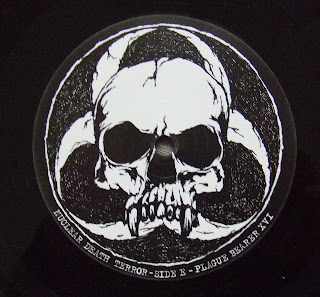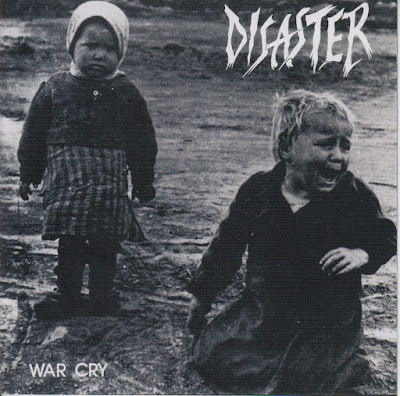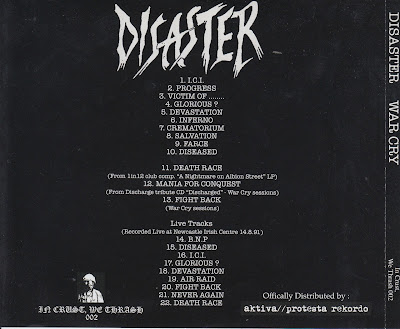I recently listened to Hard Skin's song "Not messing around", a banger telling the story of a proper skinhead, quite likely a supporter of Millwall FC who is faithful to the traditional way of life. Most of all it's about a simple man who strives to live his better life and if it must include dancing the tango and the foxtrot, drinking whisky instead of bitter, then so be it. Once a bootboy always a bootboy as the saying goes. Inspiring shit indeed. Working-class heroes ain't messing around and if this song doesn't motivate you to get off your fat arse, what will?
Do you know who else are not messing around? Global Holocaust and Massgrave, that's who. While the latter have made a name for themselves since their inception in 2003, the former has largely remained a band that would be best defined, as Mel Brooks put it, as a world-famous band in their home country. Local "legends" I guess. I first heard of GH through the Montreal Crust-Fucks compilation cd. It would have been released in 1999 or 2000 (the band Oppressed Conscience mentioned John Paul 2nd's 2000 speech in which he apologized for the heinous crimes of the Church - it was a bit late for that mate) and I remember ordering it from a distro called React that was active in the 90's and 00's and had a lot of pretty obscure noisy delicacies from all over the world. To be honest, I picked that one because it was cheap, everything seemed to be on this distro, and I was curious about Montreal crust bands - I only knew Hellbound and After the Bombs which I both loved - and the compilation, with its rather transparent title, promised just that. It is a fun record, still crusty but with some diversity, and along with Disagree (the best band here), GH definitely won me over.
After a quick research I understood GH were pioneers and had been rather crucial in the making of the Montreal crust scene (assuming the very term "scene" is relevant to refer to 30 people). It's fair to say that the name and the vintage crustier-than-thou font give the genre away. They formed as early as 1989 which made them a second-generation crustcore band although they arsed around in the studio for a while because their first recording, the demo tape Hope?, was only released in 1993. From 1995 to 1999 they certainly made up for lost time, or started drinking more reasonablu, and no less than six Ep's, among which four splits with fellow Montreal bands Oppressed Conscience, Obnoxious Race and Urban Trash and another Québec-based band Fierce.
During the 90's GH enjoyed a stable lineup with Simon, on drums, being a tireless musician (he also played in Préjudice, Disjonction and three of the aforementioned bands GH did splits with) and running Tobacco Shit Records that released most of GH's records and other Canadian bands. Sonically they were in line with the decade had to offer as far as the genre was concerned: gruff crustcore with a thrashing grindcore influence like Destroy! dating Toxic Bonkers at a Fleas & Live gig. One of the strongest points, if not the strongest, was Fred's vocals, instantly recognizable, that able to sound raucous and coarse but also very pissed and discernible, on the verge of dementia. Really good work here. The band then stopped in 1996 after being "banned in the city" whatever that means. I could not find any details about this ban. Did it involve some of rioting that ended up with police forbidding them to play in Montreal? That'd be legendary so I guess we would be able to find stories about it online. Were they just kicked out after a particularly poor gig? If you know the full story, let me know and I'll add the thing here.
The band reformed in 2006 with a new guitar player and let's get real: they did not change much. The grindcore moments were pretty much gone but in terms of production and textures, the two songs on this split Ep could have been recorded in 1996, as if time had had no effect on these thick-skinned crusties. We're still heavily in thrashing crustcore land and I am reminded of Brazilian thrashing hardcore legend Armagedom. Simple and rather good, I think the split Ep format fits the band very well here. GH would released another split Ep with Dehumanizer Earth the same year and a full Ep in 2008 with seven (!) different covers, six of which being (loving) rip-offs of other bands like Antischism, DS-13 or Tragedy. Granted those were very limited pressings but that cracked me up. You've got to love punks with a cheeky sense of humour.
On the other side the listener is treated with three songs from the mighty Massgrave from Vancouver (not to be confused with the short-lived but excellent Japanese Massgrave). I am not sure it would be correct to claim that MG were ever a trendy or a high-profile band (on the punk scale being a high-profile act means to have a queue of at least seven people at the merch table, it's simple maths really) but they have clearly become an established band and even people who are not into crust or grindcore (also known as posers) are at least a little familiar with them (if not with the actual music at least with how much they stand for the genre). They have been one of the very few contemporary bands to be able to totally appeal to both crust and grind crowds. Depending on the size of your town, there may not be a difference between these crowds. Actually in small towns everybody go to "the punk gig" whether they are into metalcore, melodic punk or neocrust because it would be pointless to form silly little scenes. But in bigger places where silliness is key, as far as I can see, a division has grown and solidified between the d-beat/crust audience and the full-on grindcore one. It's the case even in Paris, a town that has never been famous for either genres (that's an understatement, we're infested by oi music) that don't draw many people anyway unless you bring a bigger name. But MS are something of an exception in the sense that they are a solid DIY punk band, first and foremost, playing music that not only appeals to more but also, as an openly political band, avoids the tastelessness and stupidity that too many grindcore bands intentionally embrace. They are basically a good band with a delicately hairy font.
I first heard about them when a good friend of mine ages ago, far more into grindcore than I ever will be, mentioned that Stormcrow would appear on a split Lp with Massgrave to be released soon on Agipunk. Not being aware of the existence of said band, I proceeded to ask about their identity. He described them as "kinda like Disrupt or State of Fear but more manic and with more blast beats, even " and he was quite right. He then added that "even someone with shit tastes like you should enjoy it" which somehow negatively impacted the discovery. Oh well. By 2006 MG had already released two albums, a split cd with Neckbeerd (that involved a member of MG) and a strong full album entitled ...People are the Problem, and four Ep's, three of them being, in true DIY grindcore fashion split records with Warfair?, Pretty Little Flowers and Poser Disposer (I like the name of that one and the spoof Anti Cimex cover). The three songs on the present split are vintage 00's Massgrave, absolutely furious and relentless grinding cavemen crustcore with dual tradeoff vocals reminiscent of late Disrupt, 3-Way Cum or Deformed Conscience. The band sounds absolutely unstoppable and ferocious here, the production is amazing, powerful in that it relies on the energy and aggression of the songwriting to create that vibe of brutal and angry hardcore punk savagery and still provide significant changes of pace. They were at the top of their early game and this is one of my favourite recordings from the band. Short and sweet to be sure and with a limited amount of blast beats which suits me well. What a slap in the face.
The vocalists are perfectly complementary and manage to recreate an argument between angry cavemen about who did not watch the fire properly. The riffs are top notch too and show that Sweden was certainly a country that the guitar player looked up to while the very sound and tone of the guitar is quite specific and makes the band easy to recognize. Back when the band started the traditional dual vocals crustcore style was slowly vanishing and it would soon go out of fashion after the mid-00's (Visions of War standing as the immortal heroes of the (sub)subgenre). I would venture that the fact that MG was significantly connected with the grindcore scene (most of their collaborations were with grind bands) that value brutality somehow made it easier for them to develop their specific grinding crust attack and build momentum. I had the opportunity to see them twice (I put on the second gig myself) and I had a blast.
This record was released on Unrest Records when the label was still in its infancy. Little by little it would become a well-respected label responsible for records from the likes of Disrupt (well, that one made sense), The Accüsed, Driller Killer and even Morus. The main flaw of this Ep is the cover, a little confusing visually and without any reference to the bands included, unless you know the record beforehand, it's not one you would necessarily want to check on the distro table. Let's call this a punk tradition.
























































